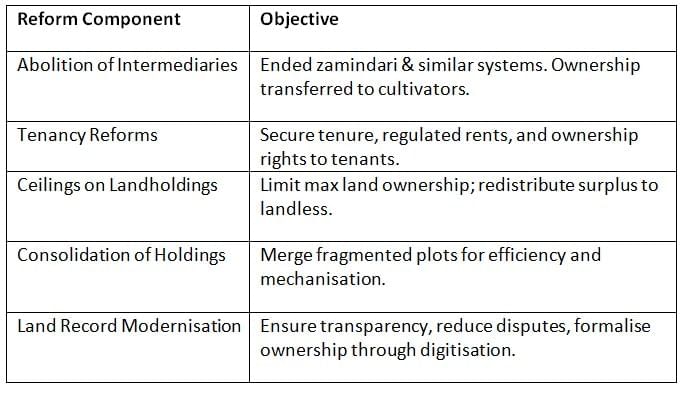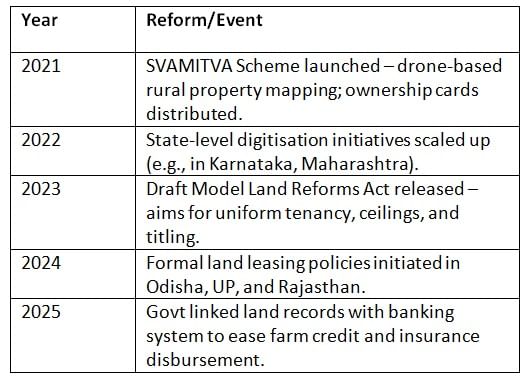UPSC Exam > UPSC Notes > Indian Economy for UPSC CSE > Cheat Sheet: Land Reforms in India
Cheat Sheet: Land Reforms in India | Indian Economy for UPSC CSE PDF Download
| Table of contents |

|
| Introduction |

|
| Major Components of Land Reforms |

|
| Constitutional and Legal Basis |

|
| Implementation Outcomes |

|
| Recent Developments (Till 2025) |

|
| Contemporary Challenges |

|
Introduction
Aimed to restructure agrarian relations post-independence.
Key goals:
- Eliminate intermediaries (zamindars).
- Ensure land to the tiller.
- Redistribute surplus land.
- Improve agricultural productivity.
- Secure tenancy and consolidate holdings.
Major Components of Land Reforms

Constitutional and Legal Basis
- Article 39(b) & (c) – Equitable distribution of material resources (Directive Principles).
- 9th Schedule – Protected land reform laws from judicial review (later limited by Supreme Court).
- Land as a State Subject – States have autonomy; hence implementation varies.
Implementation Outcomes

Recent Developments (Till 2025)

Contemporary Challenges
- Landlessness still widespread in rural India (~20% households are landless).
- Informal tenancy persists; tenants lack access to subsidies/insurance.
- Gender disparity in land ownership remains despite inheritance law amendments.
- Conflict over land due to urban expansion and infrastructure projects.
- Land disputes form ~66% of all civil litigation in India.
The document Cheat Sheet: Land Reforms in India | Indian Economy for UPSC CSE is a part of the UPSC Course Indian Economy for UPSC CSE.
All you need of UPSC at this link: UPSC
|
173 videos|487 docs|159 tests
|
FAQs on Cheat Sheet: Land Reforms in India - Indian Economy for UPSC CSE
| 1. What are the major components of land reforms in India? |  |
Ans. The major components of land reforms in India include the abolition of zamindari system, redistribution of land to the landless, tenancy reforms to ensure security of tenure, and ceiling on agricultural landholdings. These reforms aim to reduce inequalities in land ownership, enhance agricultural productivity, and improve the socio-economic conditions of marginalized farmers.
| 2. What is the constitutional and legal basis for land reforms in India? |  |
Ans. The constitutional and legal basis for land reforms in India is primarily rooted in Article 39(b) and 39(c) of the Directive Principles of State Policy, which mandate the state to ensure equitable distribution of material resources and promote the welfare of the people. Additionally, various legislative measures such as the Land Reforms Act, Tenancy Act, and the Ceiling on Land Holdings Act provide the necessary legal framework for implementing land reforms.
| 3. What have been the outcomes of land reforms in India? |  |
Ans. The outcomes of land reforms in India have been mixed. While land reforms have succeeded in redistributing land to a certain extent and have provided security of tenure to tenants, challenges such as poor implementation, lack of political will, and bureaucratic hurdles have limited their effectiveness. In some regions, the reforms have led to increased agricultural productivity and improved livelihoods, but in others, they have resulted in land fragmentation and disputes.
| 4. What are the recent developments in land reforms in India? |  |
Ans. Recent developments in land reforms in India focus on digitization of land records, introduction of new policies to enhance land acquisition processes, and integration of technology for better management of land resources. There has been an emphasis on ensuring land rights for marginalized communities and promoting sustainable agricultural practices, reflecting a shift towards more inclusive and environmentally friendly approaches.
| 5. What contemporary challenges do land reforms face in India? |  |
Ans. Contemporary challenges for land reforms in India include issues such as land disputes, bureaucratic inefficiencies, resistance from traditional landholders, and the impact of urbanization and industrialization on agricultural land. Additionally, the lack of awareness among farmers about their rights and the complexities in legal frameworks hinder effective implementation, necessitating a comprehensive approach to address these challenges.
Related Searches















